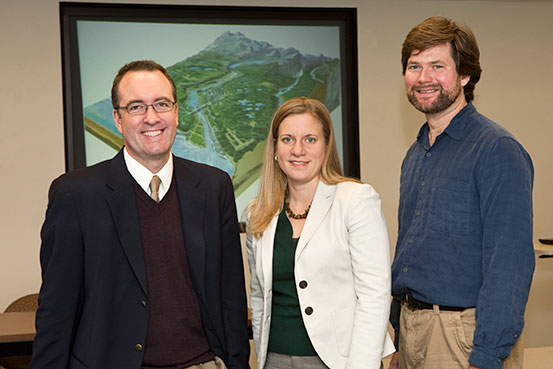



By beth chajes Delaware Environmental Institute

Place a glass of water before UD faculty members Kent Messer, Holly Michael and Joshua Duke and ask them what they know about it, and you’re likely to get three very different answers.
Messer, a behavioral economist, might tell you the price a consumer would be willing to pay for the water given various levels of purity or contamination.
Michael, a hydrogeologist, could describe where the water came from and whether it was pumped from the ground or diverted from a creek in Delaware.
And Duke, an environmental economist, could expound on principles governing the use of a common property resource like groundwater.
Put together all three perspectives, and you’ll come away with a pretty full and compelling story about one of Delaware’s most precious natural resources.
The trio has joined forces on a pair of National Science Foundation grants to provide a more complete account of the water sustainability challenges and options facing Delaware and other areas vulnerable to sea level rise in the coming decades.
“Delaware’s not going to run out of water,” says Duke, “but it might run out of clean water. Whether it’s toxins from a brownfield or salt water from sea level rise—or a combination—that migrates into drinking water, contaminant-free water is going to be harder to come by in the future.”
The statistics are sobering. In Delaware, more than 700 contaminated industrial sites dot the landscape. New Castle County, the northernmost of Delaware’s three counties, where 70 percent of the state’s residents live, has more contaminated sites per square mile than all but three other counties in the United States. A survey by the Department of Natural Resources and Environmental Control counted 159 certified brownfields in the state, including 103 in the city of Wilmington, leftovers of its long industrial history.
Seventy-five percent of the drinking water provided to New Castle County residents comes from surface water, primarily the various tributaries of the Christina River. Below the Chesapeake and Delaware Canal, though, all drinking water—as well as water for irrigation and most industrial uses—comes from groundwater. And while contaminated sites are sparser in southern Delaware, drawing water from wells beneath agricultural lands and coastal plains provides its own set of hazards.
Both research projects undertaken by the team in recent months seek to predict changes in future water resource use in Delaware by integrating the sciences of groundwater hydrology and soil and water chemistry with economics and policy.
In their first project, a three-year, $369,000 NSF grant shared with Jordan Suter of Oberlin College, the team is integrating economic and hydrologic models to take into account feedback loops from human interactions with the environment.
“Groundwater doesn’t just sit in one place,” Michael explains. “It flows through the ground because of various physical forces that we can explain through mathematical models. When humans interact with this system, by pumping groundwater for example, it changes the physics of how the groundwater flows.”
Pumping in one area, she says, may draw water away from another area, causing a neighbor to have to pump water from deeper in the Earth in order to meet his water needs. That’s where Messer and Duke enter the picture with their own models and experiments to measure the economic costs associated with that reaction, to provide insight into human decision-making and to test policy solutions.
As director of the Laboratory for Experimental and Applied Economics at UD, Messer runs experiments with human volunteers who are paid real money to play computer simulation games. Messer alters the conditions, adding a drought here, a contaminated well there, and keeps track of how his subjects respond to changing conditions.
“Because they get to keep the money left at the end of the simulation, my subjects are motivated to make economic decisions that they perceive are in their best interests,” Messer says.
In their second NSF project, the trio is working with Donald Sparks, S. Hallock du Pont Professor of Soil and Environmental Chemistry, to study the effects of anticipated sea level rise on contaminated sites. Their hypothesis is that alterations in hydrology and chemistry of contaminated soils in urban areas, industrial sites and waste disposal sites as the result of sea level rise could enhance the release and mobility of contaminants currently sequestered in the soil, threatening drinking water supplies and food sources.
The study has two major thrusts. The first is to assess the effects of sea level rise on the chemistry and hydrology of contaminated sites. The team will look at sites in Wilmington and in southern Delaware, where the types of contaminants and the hydrology are significantly different. The second thrust is to measure the value people place on changes in risk to their health from contaminated water and on various responses, either technological or behavioral, that could decrease that risk.
Many more visible effects of sea level rise, such as the consequences for coastal infrastructure like roads and bridges, have attracted plenty of attention from researchers. Thus far, however, the interplay of salt water, soil contaminants, hydrology and human behavior has received scant notice. As leaders of a novel approach to a problem just now receiving recognition, the team expects to host a workshop on the theme of water sustainability, contaminants and sea level rise in the spring of 2013.